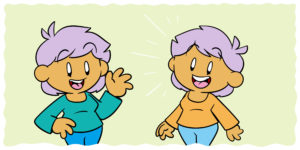When it comes to writing a story, the beginning and the end tend to get all the attention. If you’re relating a story, you’re probably going to explain where things begin, the central goal, and whether or not it’s reached. If an author manages to produce a particularly gripping middle – the Battle of Helm’s Deep or the narrator switch in Gone Girl – it might get a mention, but otherwise it tends to fall by the wayside.
There’s a reason this is the case, and it’s the same reason that the middle of your story may be letting down the whole. In this article, I’ll be taking a look at why the middle is so often overlooked and what you can do to avoid the consequences.
Why the middle doesn’t matter
In terms of the mechanics of storytelling, there’s an argument that the middle of your story is just there to fill space. In a traditional story, the beginning establishes the world, characters, motivations, and goals, while the end ties up those threads in a satisfying way.
As with many writing techniques, this idea is made clearer by turning to that basic expression of narrative, the fairy tale. In Goldilocks and the Three Bears, the story is divided as follows:
- Goldilocks arrives at the bears’ house, intending to explore and enjoy herself,
- She explores and enjoys herself,
- The bears arrive home and, depending on the teller, Goldilocks runs off or is devoured.
This is a story that only barely needs its middle; in fact, the middle is almost wholly there just so there is a middle – so the reader has space to understand the stakes and develop expectations for the payoff. Goldilocks performs three actions three times (sitting, eating, sleeping), but what those actions are doesn’t truly matter, so long as they fill the allotted time.
More complex stories might not offer as clear of an example, but it’s the norm for the middle of the story to offer little mechanical utility, simply providing a space for events and characters to gain texture and build relevance. Of course, stories aren’t just their mechanics…
Why the middle matters
To say that the middle of a story ‘only’ lends meaning to the beginning and end is to misunderstand the mechanical necessity of space and time. It may be a simple job, but it’s a job that needs doing. The middle of Goldilocks is malleable in terms of detail, but take it out and the story falls flat.
Once upon a time, a little girl named ‘Goldilocks’ broke into the house of three bears. Later, they came home, and she ran away.
It’s not exactly a classic, and that’s because the details of what Goldilocks does increase the risk factor and allow the reader to anticipate the likely consequences.
While the middle of a story is mechanically simple, it’s where a huge amount of the necessary craft takes place. This is where the author establishes not the factual stakes but their emotional weight, turning characters from theoretical entities into people the reader cares about.
The middle of the story is where the battles, the romance, and the revelations take place. Mechanically, they may only decide who’s present for the ending, but that doesn’t mean they’re surplus to requirements.
A story’s middle is mechanically simple, but it’s the natural home of craft.Click To TweetStill, while the middle of your story is definitely important, its mechanical simplicity can lead to issues with how you write it.
How mechanical simplicity hurts stories
The big problem with the mechanical simplicity of a story’s middle is that it doesn’t offer much of a roadmap. A beginning has almost a checklist of goals – which characters and ideas need to be introduced, what elements of the world need to be explained – while the end has plot threads barreling towards it for conclusion. In both cases, the author is forced to make decisions, to establish a hierarchy of importance, and while they may improve on those decisions in later drafts, it’s somewhere to start.
In contrast, the middle’s only concrete remit is to take the reader from the beginning to the end, and even then, things aren’t so clear. Usually, the first version of a story’s plot is working towards a hypothetical end, so there’s nothing truly drawing the middle forward; nothing it needs to do by a certain point.
The good news is that this is perfectly natural. It’s a popular saying among authors that you need to write the wrong middle to find the right one, and this is true. Not only that, but once you have the wrong middle, you’ve got the raw materials you need to improve this section of your work.
Visualizing the middle of your story
The lack of a blueprint for the middle of a story tends to create one of two problems. The first of these is the flat middle – a period between the beginning and the end where nothing much happens. The characters are shifted around the board, encountering minor obstacles, busywork quests, minor personal disagreements, and basically killing time until the story’s ready to finish. Worst of all, a flat middle feels like killing time. The reader knows there aren’t going to be any serious consequences for a while, they can sense the lack of direction, and the majority of the book feels like a slog, albeit one that gets more interesting if you can stick it out until the end.
At the other end of the spectrum is the messy middle. Here, the author has the content they need to make the middle interesting but lacks a clear idea of how it should coalesce. Consequently, the content runs wild, with an inconsistent parade of unconnected moments leading to tonal inconsistency and wasted opportunity. Big moments suck the energy from smaller developments, events that could have bolstered each other in the right order are squandered, and plot devices that could be slowly foreshadowed and developed come from nowhere.
Happily, though these problems are basically opposites, they have similar solutions that you can implement as you edit. As I said above, writing your ending will put you in a great position to improve the middle of your story. If you’re still on the first draft of your story (and a problematic middle isn’t standing in the way of your ending), my best advice is to finish. Not only does this give you an ending to shoot for, it establishes some kind of structure that you can begin to adjust. Even a terrible structure is a better place to start than with nothing.
Sometimes, you need to write the middle just so you can write the end.Click To TweetOnce that first draft is finished, it’s time to start improving the middle of your story. The best thing you can do for a struggling middle is to reappraise it with your eye on the ending. Now that you know where things are headed, ask what the smoothest, most satisfying path to that point looks like. Partially, this is done by looking at the larger plot, but most of it means looking at each character’s journey. If you haven’t already, write out an in-depth timeline for each character and place them side by side. This will show you what each character is doing when, and, for added insight, you can color-code for intensity and/or tone to give you a sense of the reader’s journey.
This new tool will give you a visual understanding of what’s happening over the course of your story and the reader’s path through it. Look for the sections where nothing is happening or where too much is happening at once. Look for islands – either small moments that could be lost amongst big revelations or else big revelations that don’t have the build-up or impact they need. Your next edit should be about shifting around these events so the reader’s journey is consistently engaging.
It’s overly simplistic to say that the reader wants a varied journey through the story, and certainly that events should ‘build’ as one smooth upward curve. There are stories where the middle is a machine gun burst of new information and stories where it’s the calm before the storm, and both can work. Many other models are just as effective, but they work because they’re the result of deliberate, considered choices. Looking at a color-coded timeline gives you the ability to say ‘here’s what I want the reader to experience next’, and even if that choice isn’t what 99% of other authors would do, it’s still a choice, and that will shine through in how you execute it.
Use character-specific timelines and color-coding to visualize your story.Click To TweetImproving the middle of your story
When you look at your new combo-timeline and realize you don’t have the material you need to even out your story, it’s time to start creating it. This is where B stories and minor characters show their worth, giving you not just the content you need for a compelling middle, but the tools to write it well. Introducing a narrative strand other than your protagonist’s journey gives you a reason to cut away, making it easier to manage time and journey.
If your middle is fallow, consider what other authors do with this space. Where writers utilize flashbacks, the middle is their natural home, and this is where you characters can hash out any disagreements they have as individuals. It’s vital to think like an author here: it’s not useful to say ‘but they don’t have any disagreements or an interesting past’ – you control everything about them and their world, so add some. This is the place to explore theme, conceit, and imagery (though only at the same time as you move the plot forward).
It can also be useful to break up the problems your heroes encounter. If they’re building to a grand conclusion, consider what elements of that conclusion can be achieved in stages. When J.K. Rowling splits her antagonist’s soul into a range of MacGuffins, it’s partly because this gives the heroes a list of tasks to accomplish over the middle of the story. As a bonus, their quest to do so leads to a lot of falling out and coming back together. If they’re building to a personal confrontation or revelation, consider what small breakthroughs they can make on their journey to that point.
It can be difficult to add goals whole cloth, especially later in a story. Throw in a new obstacle and, often, it feels unconnected to the rest of the plot, clearly identifiable as a way to kill some time. This can be ameliorated by drafting, but if you’re trying to improve the middle of a story that’s already pretty far along, consider breaking your existing obstacles into pieces. Ask what your character does and what they get from it, and identify the ‘and’s in your answer. That’s what breaks up multiple actions and consequences, and the marker for where you can extend a problem to give the middle of your story more weight. If your characters storm the castle and kill the villain, can the villain escape and need to be tracked down before they’re truly defeated, giving the characters multiple struggles and multiple victories? If your character stands up to their workplace bully and lands the new contract, can they stand up to their bully and then gain the confidence to successfully apply for the new contract, turning a single event into a satisfying progression?
Break larger obstacles into chunks to lend your middle a sense of progression.Click To TweetAs a final technique to improve the middle of your story, ask how long it needs to be. If the middle of your story just isn’t coming together, and none of the above has helped, you might just be writing a shorter story than you think. Ian McEwan’s Enduring Love is a full-length novel expanded from a short story, but it never quite escapes its origins. McEwan utilizes many of the devices described above to flesh out the story, but it’s arguable that the book simply wants to be shorter. As you work to improve the middle of your story, interrogate whether you’re trying to live up to a model that doesn’t suit your project and is only going to stretch and weaken what makes it special.
Middle’s end
When it comes to plotting and writing a story, the middle is the part where there’s least guidance; the dark forest an author has to trek through on their way to the ending. With time, effort, and insight, however, authors can ensure that the reader doesn’t go through the same thing, especially if they’re willing to invest in an editing process that digs down into the story’s structure. Whether the middle of your story is currently flat or messy, remember that getting it down on paper was the only way to start improving it. Now that you’ve reached your destination, invest in some heavy-duty pruning tools and return to the forest, hacking a path through the undergrowth that everyone who follows will think was always there.
Are you struggling with the middle of your story? Have any of the techniques above worked for you? Let me know in the comments, or check out Adding A ‘B Plot’ Is The Simple Way To Improve Your Story and Do You Really Need To Start At The Beginning? for more great advice on this topic.






4 thoughts on “Is The Middle Of Your Story Letting You Down?”
Thanks, Rob.
As a reader, I detest a story that plods through the middle.
I want a goal or conflict established at the beginning of the book, and I want every chapter to keep me guessing. Will the goal/conflict be resolved? Uh oh. Here’s a hurdle. And another. And another. I want to be pulled along like a train by its engine, sometimes steaming at top speed, other times more slowly as the story unfolds.
If I’m bored, I’ll stop reading and open another book.
Hi Kathy,
Well put, and exactly the kind of reader experience to which authors need to cater.
Best,
Rob
Probably the most insightful article I’ve read on this site. Thanks for some helpful techniques, some good advice and some encouragement I’ve needed.
Greg
Hi Greg,
My pleasure – thanks very much for the kind words.
Best,
Rob